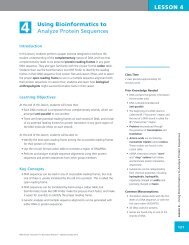WET LAB DNA Barcoding: From Samples to Sequences - Northwest ...
WET LAB DNA Barcoding: From Samples to Sequences - Northwest ...
WET LAB DNA Barcoding: From Samples to Sequences - Northwest ...
Create successful ePaper yourself
Turn your PDF publications into a flip-book with our unique Google optimized e-Paper software.
<strong>WET</strong> <strong>LAB</strong><br />
KEY<br />
Lab 4: Preparation of PCR <strong>Samples</strong> for<br />
<strong>DNA</strong> Sequencing Teacher Answer Key<br />
On your separate sheet of paper or in your lab notebook, answer each of the following questions:<br />
1. Which band in your molecular weight standard is closest in size <strong>to</strong> your PCR product, and how much <strong>DNA</strong><br />
is in that molecular weight standard band?<br />
Students should use either the 500 bp band or the 750 bp band. Both contain 25 ng of <strong>DNA</strong>.<br />
2. Is your PCR product band brighter than the band in the molecular weight standard, as bright, or less bright?<br />
Student answers will vary by experiment.<br />
3. Based on your answers <strong>to</strong> Questions #1 and #2, how much <strong>DNA</strong> would you estimate is present in 10 μl of your<br />
PCR product? (Remember, you added 10 μl of your PCR product <strong>to</strong> the agarose gel.)<br />
Student answers will vary by experiment, but should be consistent with answers <strong>to</strong> Questions #1 and #2.<br />
For example, if the student’s PCR product is half as bright as the 500 bp band containing 25 ng of <strong>DNA</strong>,<br />
the student should estimate that their <strong>DNA</strong> band contains approximately 12.5 ng of <strong>DNA</strong>.<br />
4. What is the estimated concentration of your PCR product (in ng/μl)? Show your work.<br />
Student answers will vary by experiment, but should be consistent with answers <strong>to</strong> Questions #1–3.<br />
For example, if the student estimated that their <strong>DNA</strong> band contained approximately 12.5 ng of <strong>DNA</strong><br />
(from Question #3):<br />
12.5 ng <strong>DNA</strong> / 10 μl of PCR product loaded on<strong>to</strong> the gel = 1.25 ng/μl or 12.5 μg/ml.<br />
5. What did you do in this labora<strong>to</strong>ry experiment and why?<br />
Purified the PCR product away from the PCR reaction components like primers, buffer, and <strong>DNA</strong> polymerase;<br />
estimated the concentration of the PCR product.<br />
6. What skills did you learn or practice?<br />
This question is designed <strong>to</strong> help students identify labora<strong>to</strong>ry skills that they can list on a resume and/or<br />
college application.<br />
• Handling samples<br />
• Pipetting<br />
• PCR product purification<br />
Wet Lab – <strong>DNA</strong> <strong>Barcoding</strong>: <strong>From</strong> <strong>Samples</strong> <strong>to</strong> <strong>Sequences</strong><br />
371<br />
©<strong>Northwest</strong> Association for Biomedical Research—Updated Oc<strong>to</strong>ber 2012
















